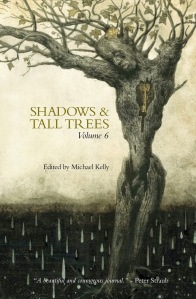I love short horror fiction. I read lots of it: magazines, ezines, collections, anthologies and single stories, but I don’t think I’ve ever read a book quite like this one.
Editor Michael Kelly obviously likes a certain kind of horror: contemporary, literary, subtle and undefined. There are no zombies, no vampires, no chainsaw-wielding psychopaths. Instead there are expertly drawn characters dealing with terrible things.
There are two main things that make this book special, compared to other anthologies I’ve read lately.
- I’ve mentioned the lack of traditional monsters, but it seemed that all the characters here are all dealing with their own ghosts, either unresolved episodes from their past or some inner demon that becomes apparent in the story. Even when there is some outside agency it’s the characters’ action or flaws that attract them. It’s almost Shakespearian.
- None of the stories resolve in a satisfactory way. I don’t mean that as a flaw, quite the opposite. Every story here leaves you guessing, either about what actually happened or how we should feel about it. This apparently simple technique means that we keep thinking about the stories after we’ve finished them. I imagine Michael Kelly writing back to some contributors saying See that bit at the end when the monster appears and explains everything – cut that and we’ve got a deal.
Horror fiction can work on many levels. I think of them as
- Jump/ yuck,
- suspense,
- creepy (glancing behind you while reading),
- making you re-examine how you live your life.
Several of these stories work on that last level, the rarest and most effective of all.
It begins by deliberately unsettling the reader with Eric Schaller’s To Assume the Writer’s Crown: Notes on the Craft. This could be read several ways: as a genuine essay with a good dose of the author’s dark humour thrown in, or as a story told by someone who actually has a girl chained up in his basement just so he can write a good story about it, or a meditation on a writer’s relationship with his characters. I think the ambiguity is entirely deliberate and it makes uncomfortable reading for those of us who regularly use ink as a murder weapon.
And the book continues in that vein. The other pieces are more obviously stories, but that feeling of never knowing what’s going on remains throughout. I enjoyed every story in this book. Seriously, there wasn’t a single piece that I would have cut, but here I’ll only specifically mention my favourites.
Onanon by Michael Wehunt. This might be based on a genuine Scandinavian folk tale I haven’t heard, or it’s just so well told it seems real. Three strands of unpleasantness converge into something disturbing.
Death’s Door Cafe by Kaaron Warren. Taking a cliché and making it literal lets us explore morbidity in a story that seems upbeat but undercuts it and needles the reader.
H. Leslie’s The Quiet Room is about your past coming to get you. A house likes silence, so you can better hear the hollowness of your life.
Shaddertown by Conrad Williams is an apparently simple story that somehow encapsulates everything that modern western adults are afraid of in real life.
Ralph Robert Moore and Ray Cluley collaborated to produce The Space Between, in which a man finds he can spy on his neighbours and it becomes a compulsion that ruins his life. I read this as a parable about Facebook and the like but even without that resonant layer it’s a chilling story.
Shadows and Tall Trees is a truly brilliant book, showcasing the most subtle horror fiction currently being written. Go buy it.
